List of Googie architecture structures
| List of Googie architecture structures | |
|---|---|
|
300 Bowl Phoenix, Arizona |
This is a dynamic list and may never be able to satisfy particular standards for completeness. You can help by expanding it with reliably sourced entries.
This is a list of Googie architecture structures which includes a photographic gallery with a brief description of some of the structures which still remain. Googie was an original architectural style which began in Southern California during the late 1940s. Influenced by the coming of the Space age Googie-themed architecture was popularity was most notable during the mid-1960s, among motels, coffee houses and gas stations. The term "Googie" comes from a now defunct coffee shop and cafe built in West Hollywood[1] designed by John Lautner.[2][3]
Googie architecture structures
The following are images of some of the Googie architecture structures remaining in the United States.
| Name of structure[4] | Image | Location | |
|---|---|---|---|
| 1 | Hope International University | |
Hope International University in Fullerton, California displays classic Googie architecture on its main building and auditorium.[5] |
| 2 | Mel's Bowl | 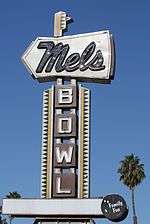 |
a example of a mid-century Googie sign" in Redwood City, California.[6] |
| 3 | The Anaheim Convention Center |  |
Anaheim, California.[7] |
| 4 | Town Motel | 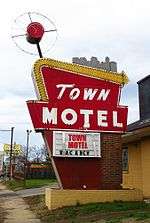 |
Birmingham, Alabama.[8] |
| 5 | Food Mart | 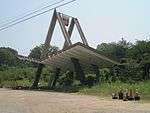 |
Woodstock, Tennessee.[9] |
| 6 | Pedestrian tunnel | |
Aberdeen, Maryland.[10] |
| 7 | Kona Lanes (since demolished) |
 |
Costa Mesa, California.[11] |
| 8 | Corky's |  |
Sherman Oaks, Los Angeles. |
| 9 | Dot Coffee Shop |  |
Houston, Texas.[12] |
| 10 | Car Wash |  |
San Bernardino, California.[13] |
| 11 | Elm Road Drive-In Theatre sign | 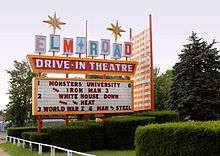 |
Warren, Ohio.[14] |
| 12 | Burbank Bob's Big Boy | 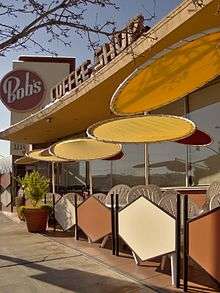 |
Burbank, California.[15] |
| 13 | The Caribbean Motel | |
Wildwood, New Jersey.[16] |
| 14 | 300 Bowl building | |
Phoenix, Arizona.[17][18] |
See also
References
- ↑ Nelson, Valerie J. (2011-04-26). "Eldon Davis dies at 94; architect designed 'Googie' coffee shops". Los Angeles Times. Retrieved 2011-05-15.
- ↑ John Lautner Why Do Bad Guys Always Get The Best Houses? October 31 by Rory Stott ArchDaily
- ↑ Friedlander, Whitney (May 18, 2008). "Go on a SoCal hunt for Googie architecture". Baltimore Sun. Los Angeles Times. Retrieved 11 February 2009.
It was the 1950s. America was a superpower, and the Los Angeles area was a center of it. The space race was on. A car culture was emerging. So were millions of postwar babies. Businesses needed ways to get families out of their automobiles and into coffee shops, bowling alleys, gas stations and motels. They needed bright signs and designs showing that the future was now. They needed color and new ideas. They needed Googie.
- ↑ National Park Service (2008-04-24). "National Register Information System". National Register of Historic Places. National Park Service.
- ↑ Hope International University
- ↑ Eslinger, Bonnie (2011-09-17). "Mel's Bowl sign in Redwood City is a real 'Googie' and should remain, group says". Palo Alto Daily News. Retrieved 2011-11-02.
- ↑ Hughes, Holly (2011). Frommer's 500 Places to See Before They Disappear. John Wiley & Sons, Inc. p. 443. ISBN 1-118-16031-2.
- ↑ Town Motel Birmingham, Alabama Googie Architecture.
- ↑ "FoodMart"- Starving outside of Millington.. Memphis,Tn ...
- ↑ Amtrak Official website
- ↑ Martelle, Scott (May 27, 2003). "O. C. Bowling Alley's Days Roll to an End". Los Angeles Times. Retrieved December 31, 2013.
- ↑ Gray, Lisa (August 20, 2014). "Parking peril for the Penguin Arms". Houston Chronicle. (subscription required (help)).
Hardly any of our Googie survives. Besides the Penguin Arms, the marvelous Dot Coffee Shop (at Gulfgate Center) remains a time-warp joy.
- ↑ Hess 2004, pp. 66–68
- ↑ Elm Road Drive-In
- ↑ Historical Marker
- ↑ "The '50s and '60s Thrive In Retro Doo-Wop Motels". Washington Post. 24 June 2007. Retrieved 2008-12-10.
- ↑ "Midcentury Marvels: Commercial Architecture of Phoenix, 1945 - 1975"; by: City of Phoenix Historic Preservation and Ryden Architects; Publisher: City of Phoenix; ISBN 978-0615409894.
- ↑ Phoenix Historic Preservation Office
Further reading
- Googie: Fifties Coffee Shop Architecture; by: Alan Hess; Publisher: Chronicle Books; ISBN 978-0877013341.
- Googie Redux: Ultramodern Roadside Architecture; by: Alan Hess; Publisher: Chronicle Books; ISBN 978-0811842723.
| Wikimedia Commons has media related to Googie architecture. |
This article is issued from Wikipedia - version of the 10/16/2016. The text is available under the Creative Commons Attribution/Share Alike but additional terms may apply for the media files.